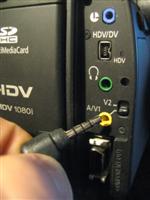Overview:
The odd VHS tape will have copy protection. The copy protection will probably be Macrovision. And here is a simple way to get around it.
Tools:
Canopus ADVC100
Summary:
Use the Canopus ADVC100 to strip the copy protection. Place the unit with the 3 cables coming from the VCR into the Canopus and either the firewire out to the computer or the 3 cables out to the DVD recorder.
Details:
(From: http://www.guygraphics.com/REVIEWS-192003.html )
(also similar but for ADVC 100: http://forum.videohelp.com/threads/233261-Canopus-ADVC-100-vs-Canopus-ADVC-110 )
Macrovision Protection/Elimination Controversy
As many people in the video editing world are aware, Canopus has been around in the mainstream for a long time. One of their earlier products was an analog to digital converter called the ADVC-100. And often, when people talk about the Canopus ADVC-110, then often refer to it as “the ADVC-100 without macrovision elimination”. This is mainly because the ADVC-110 is only slightly different from the ADVC-100. According to Canopus, they added the powered bus feature to the 110, but got rid of the ability to disable macrovision. Because of these minor changes and because the ADVC-110 and 110 look almost exactly the same, people have been asking if there was a way to still disable macrovision on the 110. Many people have offered suggestions on how to accomplish this. And although Canopus doesn’t officially support this feature on the ADVC-110, we figured we’d give it a try anyway.
How to Disable Macrovision on the Canopus ADVC-110
• Press and hold the Input Select button on the front panel for about 15 seconds
• While holding, your captured image will freeze
• When the video starts playing again, you can stop pushing the button.
• Macrovision copy-protection is now disabled until you switch off the ADVC-110
This process is pretty much the same as it was on the ADVC-100. We didn’t test this with multiple units; therefore we’re not sure if this will work for everyone. Nor are we aware if Canopus or Grass Valley will continue to allow this awesome feature to keep working. But for now, feel free to bask in the joy of a cool little tweak.
The following info is pertaining to the ADVC100:
To disable MV on the ADVC-100, you do the following:
1. while the tape is in the vcr and playing
2. be sure the advc dip switch is set to Analog -- the Rt blue light will come on
3. turn on the advc, and let it initialize completely
4. make sure tape is playing and observe the advc's red light
4a. if not on, disabling step feature does nothing, so don't waist your time pressing it
4b. if on, then proceed to disable like this:
4c. when RT blue and red light are on, press and hold down silver button for aprox 15 seconds or until the red light stop illuminating. At this point, the MV is disabled -- finished
(One thing I want to point out, and that is, that the advc may respond to different types of MV but depending on how the source vcr outputs the signal. So while the advc responds to one type of MV on your vcr it may not respond to another users' if using a different vcr. This also helps to explain why some users meet with success while others, not)
When I work with vhs transfers and conversions, I may use one of the following scenarios:
ADVC->DVCAM->CapCard
or
DVCAM->DVCAM->CapCard.


